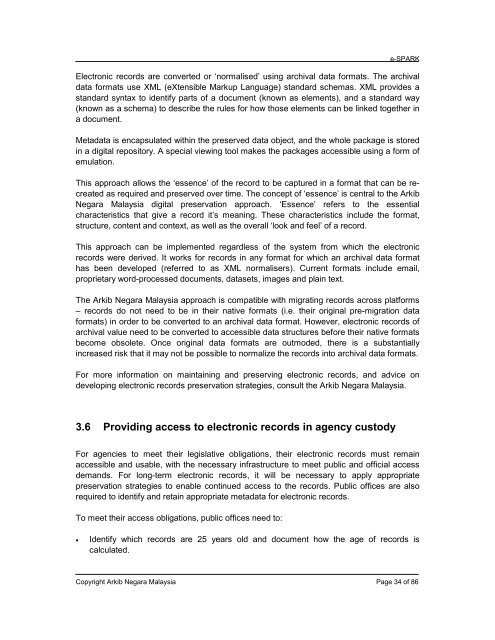Arkib Negara ELECTRONIC RECORDS MANAGEMENT and archive mgmt guideline_eng
You also want an ePaper? Increase the reach of your titles
YUMPU automatically turns print PDFs into web optimized ePapers that Google loves.
e-SPARK<br />
Electronic records are converted or ‘normalised’ using archival data formats. The archival<br />
data formats use XML (eXtensible Markup Language) st<strong>and</strong>ard schemas. XML provides a<br />
st<strong>and</strong>ard syntax to identify parts of a document (known as elements), <strong>and</strong> a st<strong>and</strong>ard way<br />
(known as a schema) to describe the rules for how those elements can be linked together in<br />
a document.<br />
Metadata is encapsulated within the preserved data object, <strong>and</strong> the whole package is stored<br />
in a digital repository. A special viewing tool makes the packages accessible using a form of<br />
emulation.<br />
This approach allows the ‘essence’ of the record to be captured in a format that can be recreated<br />
as required <strong>and</strong> preserved over time. The concept of ‘essence’ is central to the <strong>Arkib</strong><br />
<strong>Negara</strong> Malaysia digital preservation approach. ‘Essence’ refers to the essential<br />
characteristics that give a record it’s meaning. These characteristics include the format,<br />
structure, content <strong>and</strong> context, as well as the overall ‘look <strong>and</strong> feel’ of a record.<br />
This approach can be implemented regardless of the system from which the electronic<br />
records were derived. It works for records in any format for which an archival data format<br />
has been developed (referred to as XML normalisers). Current formats include email,<br />
proprietary word-processed documents, datasets, images <strong>and</strong> plain text.<br />
The <strong>Arkib</strong> <strong>Negara</strong> Malaysia approach is compatible with migrating records across platforms<br />
– records do not need to be in their native formats (i.e. their original pre-migration data<br />
formats) in order to be converted to an archival data format. However, electronic records of<br />
archival value need to be converted to accessible data structures before their native formats<br />
become obsolete. Once original data formats are outmoded, there is a substantially<br />
increased risk that it may not be possible to normalize the records into archival data formats.<br />
For more information on maintaining <strong>and</strong> preserving electronic records, <strong>and</strong> advice on<br />
developing electronic records preservation strategies, consult the <strong>Arkib</strong> <strong>Negara</strong> Malaysia.<br />
3.6 Providing access to electronic records in agency custody<br />
For agencies to meet their legislative obligations, their electronic records must remain<br />
accessible <strong>and</strong> usable, with the necessary infrastructure to meet public <strong>and</strong> official access<br />
dem<strong>and</strong>s. For long-term electronic records, it will be necessary to apply appropriate<br />
preservation strategies to enable continued access to the records. Public offices are also<br />
required to identify <strong>and</strong> retain appropriate metadata for electronic records.<br />
To meet their access obligations, public offices need to:<br />
• Identify which records are 25 years old <strong>and</strong> document how the age of records is<br />
calculated.<br />
Copyright <strong>Arkib</strong> <strong>Negara</strong> Malaysia Page 34 of 86


